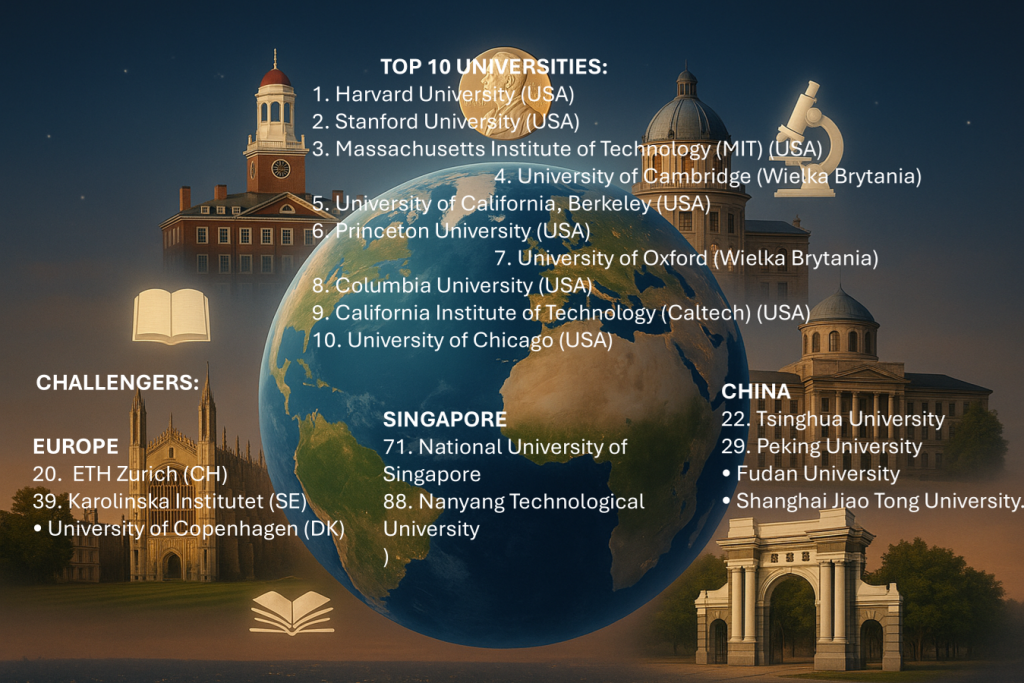
Introduction: What is the Shanghai Ranking (ARWU)?
The Shanghai Ranking, officially known as the Academic Ranking of World Universities (ARWU), is one of the most prestigious global university rankings. It was established in 2003 by Shanghai Jiao Tong University and evaluates institutions primarily based on academic and research performance. Its criteria include the number of Nobel Prize winners among alumni and staff, the number of highly cited researchers, and the volume of articles published in top-tier journals like Nature and Science.
The 2023 ranking once again confirmed the dominance of American and British universities, but it also showed the advancement of institutions from Asia and continental Europe.
TOP 10 Universities in the World in 2023
- Harvard University (USA) – 1st place (consistently for years!)
- Stanford University (USA)
- Massachusetts Institute of Technology (MIT) (USA)
- University of Cambridge (United Kingdom)
- University of California, Berkeley (USA)
- Princeton University (USA)
- University of Oxford (United Kingdom)
- Columbia University (USA)
- California Institute of Technology (Caltech) (USA)
- University of Chicago (USA)
Key Observation:
- 8 out of the top 10 universities are American, with two British institutions (Cambridge and Oxford) maintaining their elite status.
- Why? These universities have enormous research budgets, employ the most distinguished scientists (including Nobel laureates), and attract the best students from around the world.
Which Universities Are Advancing the Fastest?
1. Chinese Universities – The Scientific Powerhouse of the East
- Tsinghua University (22nd place) and Peking University (29th) – both in the TOP 30.
- Fudan University and Shanghai Jiao Tong University are in the TOP 100.
- Why? Massive government investment in science, collaboration with Western universities, and programs designed to attract international researchers.
2. Singapore – A Tiny Country with a Big Scientific Impact
- National University of Singapore (NUS) – 71st place
- Nanyang Technological University (NTU) – 88th place
- Why? Strong funding for technology and engineering, and a high degree of openness to international collaboration.
3. Continental Europe – A Stable Presence
- ETH Zurich (Switzerland) – 20th place (the highest-ranked in continental Europe)
- Karolinska Institutet (Sweden) – 39th place (a leader in medicine)
- University of Copenhagen (Denmark) – TOP 100
- Why? High levels of research funding, strong academic traditions, and international cooperation.
Why Are Some Universities So Highly Ranked? Key Success Factors
- Money = Better Science
- Harvard has an endowment of approximately $50 billion (larger than the GDP of some countries!).
- American and British universities receive huge grants from the government and private companies.
- Nobel Laureates and World-Class Scientists
- The ARWU ranking heavily rewards universities whose alumni or staff have won Nobel Prizes.
- For example, Cambridge and MIT each have several dozen Nobel laureates associated with them.
- Prestigious Publications
- Universities in the TOP 100 regularly publish in Nature and Science, which boosts their score.
- International Collaboration
- The best universities attract students and scientists from all over the world, creating global research networks.
What Are the Implications?
- Science is a financial race – Without significant funding, it is difficult to compete with Harvard or MIT.
- Asia is rising in power – China and Singapore are investing heavily in science and are already catching up with the West.
- Europe maintains its standard but lacks giants – ETH Zurich and Karolinska Institutet are excellent, but they don’t have the budgets of American universities.
- Poland is far behind – The absence of a Polish university in the TOP 300 shows that without greater investment in science, advancement is difficult.
Summary
The Shanghai Ranking shows that science is a global game of prestige, money, and talent. American and British universities still rule, but Asia and continental Europe are gradually increasing their presence. Poland still has a lot of catching up to do, but the example of China shows that consistent investment can yield results.
Could Poland ever join the world’s elite? It’s possible, but it would require significantly greater funding for science, attracting international talent, and better collaboration with global research centers.

